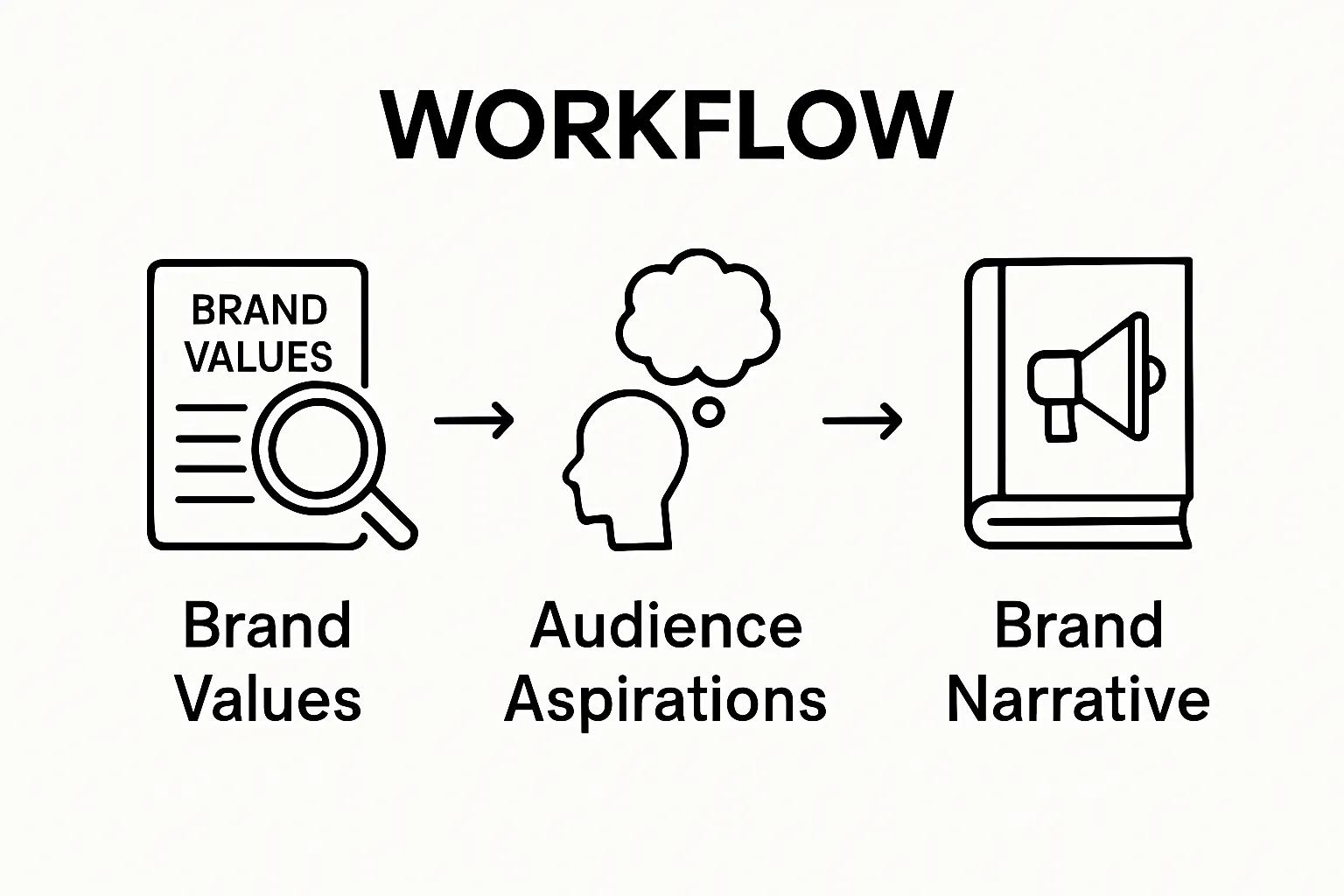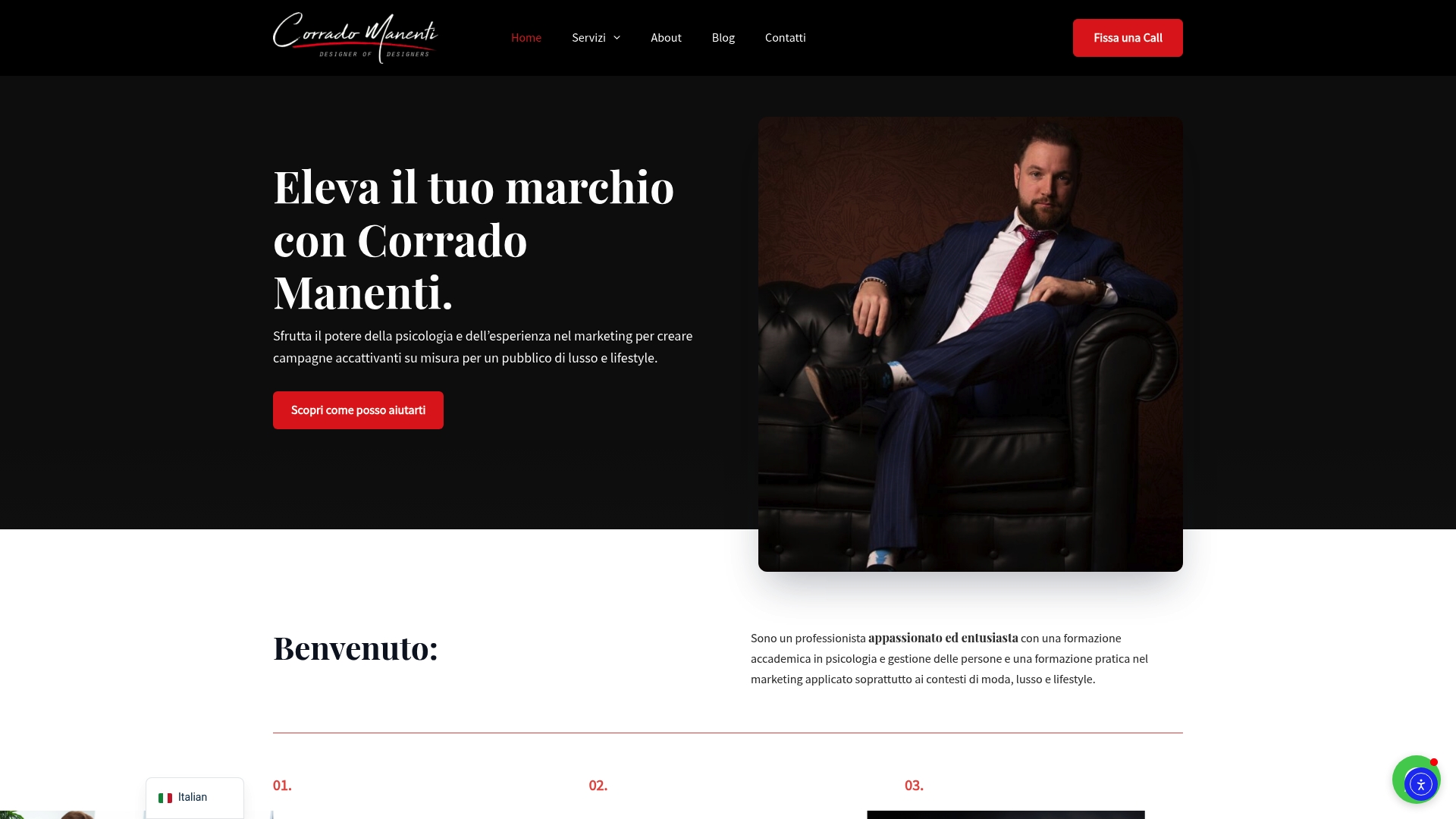Brand storytelling can feel like a mystery, but the impact is huge. Authentic brand storytelling leads to deeper loyalty and trust when everyone in your company understands and lives the core values. Most companies stop at surface-level mission statements and wonder why their message falls flat. Real success comes from a simple shift: when your values become lived actions, your narrative suddenly connects with people on a whole new level.
Table of Contents
- Step 1: Analyze Your Brand’s Core Values
- Step 2: Identify Your Target Audience’s Aspirations
- Step 3: Develop Compelling Brand Narratives
- Step 4: Integrate Stories Across All Touchpoints
- Step 5: Measure Engagement And Iterate Your Approach
Quick Summary
| Key Point | Explanation |
|---|---|
| 1. Define Core Brand Values | Articulate 3-5 core values that reflect your brand’s essence and guide decision-making. |
| 2. Understand Audience Aspirations | Create in-depth audience personas to capture emotional motivations and professional goals. |
| 3. Develop Authentic Brand Stories | Craft narratives that genuinely connect brand values with audience aspirations to enhance emotional engagement. |
| 4. Integrate Storytelling Across Touchpoints | Ensure a consistent narrative across all customer interactions to create cohesive brand experiences. |
| 5. Measure Engagement and Refine | Continuously evaluate narrative effectiveness using analytics to adapt and enhance storytelling strategies. |
Step 1: Analyze Your Brand’s Core Values
Discovering and articulating your brand’s core values is the foundational step in creating a compelling narrative that resonates with your audience. This process goes beyond a superficial exercise of listing abstract concepts—it requires deep introspection and strategic understanding of what truly defines your brand’s essence.
Begin by gathering key stakeholders from different departments to facilitate a comprehensive exploration. This collaborative approach ensures that your core values reflect the collective vision and experience of your organization. Authentic brand storytelling emerges when everyone understands and embodies the fundamental principles driving your brand.
The analysis process involves several critical reflection points. Start by examining your brand’s historical trajectory—what inspired its creation, what challenges have been overcome, and what unique perspectives distinguish you in the marketplace. Consider the emotional and rational motivations that have guided your brand’s decisions. These narratives often reveal underlying values that have been implicit but not explicitly articulated.
To structure this exploration effectively, create a structured workshop environment where participants can engage in open dialogue. Encourage team members to share stories that exemplify moments when the brand demonstrated its most authentic self. Read more about crafting compelling brand narratives to deepen your understanding of this nuanced process.
Key elements to document during this analysis include:
- Founding principles and original mission
- Consistent behavior patterns across different business contexts
- Emotional commitments to customers, employees, and stakeholders
- Unique approaches to solving industry challenges
Once you’ve gathered these insights, synthesize them into 3-5 core values that are specific, actionable, and meaningful. These values should be more than marketing rhetoric—they must be lived principles that guide decision making and organizational culture.
Verify the authenticity of your identified values by testing them against real world scenarios. Can these values withstand complex business challenges? Do they genuinely reflect your brand’s actual behavior, not just aspirational statements? The most powerful brand stories emerge when values are consistently demonstrated, not just declared.
Below is a table summarizing the key elements to uncover when analyzing your brand’s core values and verifying their authenticity.
| Element to Document | Description |
|---|---|
| Founding Principles | Core beliefs and mission at the brand’s inception |
| Consistent Behaviors | Patterns observed across multiple business contexts |
| Emotional Commitments | Pledges to customers, employees, and stakeholders |
| Unique Industry Approaches | Distinct ways your brand solves challenges |
| Real-World Scenario Testing | Assessing if values guide decisions in complex situations |
| Alignment With Actual Behaviors | Ensuring values reflect practiced, not just aspirational, standards |
| Synthesis Into 3-5 Core Values | Condensing insights into actionable guiding principles |
Successful completion of this step means having a clear, well articulated set of core values that serve as a genuine north star for your brand’s storytelling strategy. These values will become the narrative thread that connects your brand’s past, present, and future, creating a cohesive and compelling story that attracts and retains your ideal audience.
Step 2: Identify Your Target Audience’s Aspirations
Understanding your target audience goes far beyond demographic data—it requires deep psychological insight into their dreams, challenges, and unspoken desires. This step transforms your brand storytelling from a monologue into a meaningful dialogue that genuinely connects with your audience’s inner world.
Begin by creating comprehensive audience personas that transcend surface level characteristics.
These personas should capture not just who your customers are, but what drives their emotional and professional aspirations. Consider constructing profiles that explore their professional goals, personal challenges, lifestyle preferences, and the underlying motivations that influence their purchasing decisions.
To develop these rich personas, combine multiple research methodologies. Conduct in depth interviews with existing customers, analyze social media conversations, review customer feedback channels, and leverage advanced analytics tools that reveal behavioral patterns. Learn more about advanced audience segmentation techniques to refine your approach.
Pay special attention to the psychological dimensions of your audience’s aspirations. What transformative experiences are they seeking? What status symbols or personal achievements represent success in their worldview? High end brands particularly excel when they understand that customers are purchasing more than a product—they are investing in a narrative of personal evolution.
Key research areas to explore include:
- Professional advancement goals
- Personal transformation desires
- Lifestyle aesthetic preferences
- Emotional triggers and motivational frameworks
- Perceived barriers to achieving their ideal self
Utilize qualitative research techniques that go beyond traditional surveys. Organize focus groups, conduct narrative interviews, and create immersive experiences that allow participants to articulate their deeper motivations. The goal is to uncover the emotional subtext beneath their rational decision making processes.
Advanced audience research requires empathy and sophisticated analytical skills. Develop a framework that allows you to translate audience insights into compelling narrative elements. Each persona should suggest potential story arcs that resonate with their specific aspirational landscape.
Successful completion of this step means having a nuanced, multi dimensional understanding of your target audience that allows you to craft stories which feel personally meaningful. Your brand narrative should feel like a mirror reflecting their highest potential, not just a generic marketing message.
Remember that audience aspirations are dynamic. Commit to continuous research and periodic persona refinement to ensure your storytelling remains relevant and emotionally compelling. The most powerful brand stories are those that evolve alongside their audience’s changing dreams and expectations.
Step 3: Develop Compelling Brand Narratives
Crafting compelling brand narratives transforms abstract brand values into living, breathing stories that captivate and inspire your audience. This step is about creating a narrative architecture that transcends traditional marketing, turning your brand into a memorable, emotionally resonant experience.
Effective storytelling requires more than chronological events—it demands a deep understanding of narrative structure and emotional engagement. Begin by identifying the core emotional journey that connects your brand’s values with your audience’s aspirations. This narrative should feel like an invitation, not a presentation—drawing listeners into a world where they can envision their own transformation.
Consider your brand story as a multi dimensional experience. Each narrative should contain multiple layers: the origin story that explains your brand’s purpose, the ongoing mission that drives your innovation, and the transformative potential you offer to your audience. Explore advanced storytelling techniques for luxury brands to refine your approach.
Develop narrative frameworks that incorporate these critical storytelling elements:

- Central protagonist (often representing your ideal customer)
- Meaningful conflict or challenge
- Transformative journey
- Resolution that demonstrates brand value
- Emotional resonance and aspiration
Authenticity is the cornerstone of compelling narratives. Avoid manufactured or overly polished stories that feel disconnected from reality. Instead, focus on genuine moments of human experience that reveal your brand’s true character. These narratives should feel intimate, revealing the real people, challenges, and motivations behind your brand.
Consider multiple narrative formats to keep your storytelling dynamic. This might include founder stories, customer transformation journeys, behind the scenes glimpses of your creative process, or explorations of how your brand solves complex challenges. The key is maintaining a consistent emotional tone that aligns with your core brand values.
Remember that modern audiences are sophisticated storytelling consumers. They can quickly distinguish between genuine narratives and marketing manipulation. Your stories must demonstrate vulnerability, showcase real challenges, and offer genuine insights into your brand’s unique perspective.
Successful narrative development means creating stories that are simultaneously specific and universal. They should feel deeply personal yet broadly relatable, inviting audience members to see themselves within your brand’s journey. The most powerful brand narratives do not just describe what you do—they illuminate why you do it and how that purpose can transform your audience’s world.
Verify your narrative’s effectiveness by testing it across different audience segments. Does it resonate emotionally? Can people see themselves in the story? Does it authentically represent your brand’s values and vision? Continuous refinement is key to maintaining narrative relevance and impact.
Step 4: Integrate Stories Across All Touchpoints
Creating a compelling brand narrative requires seamless integration across every customer interaction point. This step transforms your storytelling from isolated moments into a holistic, immersive experience that consistently communicates your brand’s core values and emotional promise.
Consistency is the cornerstone of powerful brand storytelling. Every touchpoint—from digital platforms to physical interactions—must reflect a unified narrative voice that feels authentic and intentional. This means developing a comprehensive storytelling strategy that transcends traditional marketing boundaries and creates a cohesive brand experience.
Begin by conducting a comprehensive audit of all existing customer interaction channels. Examine your website, social media platforms, customer service protocols, packaging design, physical spaces, and communication materials. Each element should not just communicate information, but actively contribute to your overarching brand narrative. Learn more about comprehensive brand storytelling workflows to refine your approach.
Consider these critical integration touchpoints:
- Digital platforms and website design
- Social media communication
- Customer service interactions
- Physical retail or service environments
- Product packaging and design
- Employee training and communication
- Marketing and advertising materials
Develop a detailed brand communication guideline that provides clear directives on narrative tone, visual language, and emotional resonance. This document should serve as a comprehensive reference for all team members, ensuring that everyone understands how to authentically represent the brand’s story.
Payment attention to the subtle emotional cues embedded in each interaction. A customer service representative’s language, the design of your website’s user interface, or the aesthetic of your product packaging—each element should subtly reinforce your brand’s core narrative. The goal is to create an immersive experience where every interaction feels like a chapter in your brand’s ongoing story.
Technology offers powerful tools for creating personalized, dynamic storytelling experiences. Leverage data analytics and customer insights to develop adaptive narratives that can be tailored to individual customer journeys. This might involve creating dynamic content that responds to user behavior or developing interactive storytelling platforms that invite customer participation.
Successful integration means that your brand story feels seamless and natural across all platforms. Customers should experience a consistent emotional thread whether they are browsing your website, interacting with customer service, or experiencing your physical products. The narrative should feel so intuitive that it becomes an integral part of their own personal experience.
This table provides a checklist to verify whether your brand storytelling is effectively integrated across all customer touchpoints and consistently delivers your core narrative.
| Touchpoint | Integration Check | Emotional Consistency Ensured? |
|---|---|---|
| Website & Digital Platforms | Narrative voice and story elements are present | Yes/No |
| Social Media | Consistent tone and storytelling in posts | Yes/No |
| Customer Service | Staff language supports brand values | Yes/No |
| Physical Retail/Service Spaces | Atmosphere and visuals match story | Yes/No |
| Product Packaging & Design | Reflects core narrative in look and messaging | Yes/No |
| Employee Communication | Internal culture is aligned with story | Yes/No |
| Marketing/Advertising Materials | Story elements and voice are applied consistently | Yes/No |

Verify your integration success by conducting periodic cross channel audits. Are all touchpoints communicating a consistent story? Do they evoke the same emotional response? Continuous refinement and alignment are key to maintaining a powerful, resonant brand narrative.
Step 5: Measure Engagement and Iterate Your Approach
Measuring brand storytelling effectiveness transforms your narrative from a static communication strategy into a dynamic, responsive ecosystem of audience interaction. This critical step ensures that your storytelling remains relevant, emotionally resonant, and strategically aligned with your audience’s evolving expectations.
Effective measurement goes beyond traditional metrics—it requires a holistic understanding of how your narrative influences audience perception and behavior. Develop a comprehensive measurement framework that captures both quantitative data and qualitative insights, creating a nuanced view of your brand storytelling’s impact.
Establish a robust analytics infrastructure that tracks engagement across multiple dimensions. According to leading content marketing research, this involves collecting data that reveals not just surface level interactions, but deeper emotional connections.
Key measurement dimensions to explore include:
- Emotional resonance indicators
- Audience interaction depth
- Narrative reach and amplification
- Conversion rate correlations
- Sentiment analysis across platforms
Sophisticated storytelling measurement requires advanced analytical tools and a multi dimensional approach. Implement analytics platforms that can track complex user journeys, revealing how your narrative influences different stages of customer engagement. Look beyond simple view counts or likes—focus on metrics that demonstrate genuine audience investment.
Develop a continuous iteration protocol that transforms measurement insights into actionable narrative refinements. This means creating a flexible storytelling framework where data directly informs narrative evolution. Your brand story should be a living document, constantly adapting to audience feedback and changing market dynamics.
Integrate qualitative research methods alongside quantitative analytics. Conduct periodic audience interviews, focus groups, and sentiment analysis to understand the emotional landscape surrounding your brand narrative. These human insights provide critical context that pure numerical data cannot capture.
Establish regular storytelling performance reviews where cross functional teams analyze engagement metrics. These sessions should explore not just what happened, but why certain narrative elements resonated or fell flat. Encourage a culture of curiosity and continuous learning where data becomes a tool for creative improvement.
Successful measurement means developing a nuanced understanding of how your brand narrative influences audience perception. Your goal is to create a storytelling approach that feels simultaneously strategic and emotionally authentic. The most powerful brand stories are those that can adapt and grow while maintaining a consistent core identity.
Verify your measurement approach by ensuring it provides actionable insights that directly inform narrative strategy. Can you clearly articulate how audience data is translating into storytelling improvements? The ultimate test is your ability to use measurement as a creative tool for deeper audience connection.
Ready to Make Your Brand Story Truly Unforgettable?
If you have ever struggled to connect your brand’s values with your customers’ deepest aspirations, you are not alone. Many leaders in the fashion, luxury, and lifestyle sectors realize that powerful storytelling demands more than just beautiful words. It calls for a deep understanding of human psychology, flawless narrative integration, and a commitment to measuring real emotional engagement. If you want to overcome these challenges and create stories that last, now is the time to take action. Explore advanced strategies for Personal Branding and see how real psychological insight can transform your message.

Unlock your brand’s full storytelling potential with Corrado Manenti. Partner with a specialist who combines psychology-driven marketing and luxury expertise to help you build lasting emotional connections. Visit Corrado Manenti’s main site and claim your edge in brand storytelling today—you deserve to see your unique narrative make a real impact. If you want more inspiration or best practices for fashion brands, explore the Fashion VS Influencer insights. Your next-level brand story starts now.
Frequently Asked Questions
What are the key steps to enhancing brand storytelling?
The key steps include analyzing your brand’s core values, identifying your target audience’s aspirations, developing compelling brand narratives, integrating stories across all touchpoints, and measuring engagement to iterate your approach.
How can I effectively analyze my brand’s core values?
To analyze your brand’s core values, gather key stakeholders for collaborative discussion, examine your brand’s history and unique perspectives, and document founding principles and emotional commitments to synthesize them into 3-5 actionable core values.
What elements should I incorporate into my brand narratives?
Incorporate elements such as a central protagonist that represents your ideal customer, meaningful conflict or challenge, a transformative journey, resolution demonstrating brand value, and ensure emotional resonance and aspiration throughout the story.
How do I measure the effectiveness of my brand storytelling?
Measure effectiveness by establishing an analytics framework that tracks emotional resonance indicators, audience interaction depth, narrative reach, and conversion rates, combining qualitative insights with quantitative data for a comprehensive understanding.



